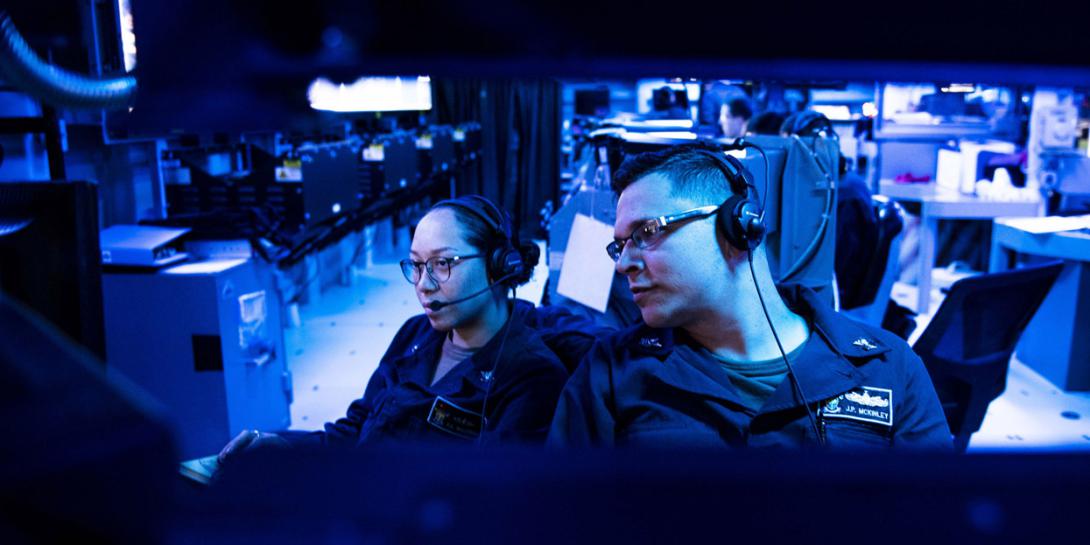Chinese Threat Dominates INDOPACOM Intelligence
The U.S. Indo-Pacific Command (INDOPACOM) harbors no illusions about China’s capabilities and intentions, its officials say. Experts who long have followed the Middle Kingdom’s official publications and statements have understood the nation’s aggressive nature and threat to peace and security, according to the director of intelligence (J-2) for INDOPACOM. These issues are now front and center for INDOPACOM as China expands its military and political reach to disrupt the peace and security of the entire Indo-Pacific region.
Rear Adm. Michael Studeman, USN, the INDOPACOM J-2, relates that intelligence experts have been following China’s rise closely since the late 1990s. Many in the community read Chinese writings and knew that events would lead to the current environment, although it took a lot of convincing to bring others to this view. He notes that the command did not have the equivalent of a post-9/11 overseas contingency operations (OCO) funding source for significant upgrades beyond baseline resources. Some additional resource support is coming to INDOPACOM, he allows, but the command must significantly upgrade “across the board” if it is to pursue the goals of the National Security Strategy and National Defense Strategy.
“The intelligence mission always had the China account robustly followed,” the admiral says. “But the sheer number of demands on intelligence today vastly exceed what our baseline is, and so we’re in the process of looking at a number of different things, including manpower, to re-envision how we ought to be operating our J-2 JIOC [Joint Intelligence Operations Center] out here.”
An increasing number of U.S. partners are “rightly suspicious” of Chinese power and how the country is exerting it, the admiral warrants. China’s increasingly frequent use of coercion and interference in others’ sovereign matters are examples of “a new form of arrogance and the use of a combination of soft, hard and sharp power” that have created more intelligence sharing opportunities in the region for INDOPACOM.
“We have been able to have very open conversations about the naked use of power, whether on the economic, military, diplomatic or informational fronts,” the admiral relates. “So the good guys are coming together as a result of very clear dangers that are posed by the Chinese way of governing and how they like to see the world order shift. The Chinese are driving partners into our arms,” he declares.
This is happening from Pacific island nations all the way west to India, and he describes it as a function of China’s leader, Xi Jinping. A lack of patience on the part of the current Chinese government coupled with a misassessment of international conditions has contributed to this drive, he says. Chinese leaders misapprehended the dynamics of the 2008 financial crisis by believing it was evidence of a permanent U.S. decline. “They were rushing history,” Adm. Studeman charges.
Consequently, China initiated a fear spiral. Southeast Asian nations are arming themselves, and many U.S. allies and partners that cannot agree with the Chinese view of shaping the future are demonstrating more backbone. “What you’ll see is a number of friends and partners that will be clustering for warmth with the United States and our allies as we move forward,” the admiral predicts. “The Chinese have made a big strategic error, all driven by Xi Jinping and the superhawks in Beijing.”
Meanwhile, INDOPACOM continues to face traditional intelligence challenges against a rogue’s gallery of threats ranging from peer competitors to terrorist groups. Those threats are not fading, but instead are honing their expertise to try to disrupt the U.S. security and economic growth model that has brought increasing prosperity throughout most of the vast region.
When it comes to intelligence collection and sharing, Adm. Studeman describes the command as “delighted at times, but never satisfied” with either area. His office must spend “a significant amount of time” working in both areas. Issues include the intelligence target and the challenge to information sharing.
Time is of the essence, Adm. Studeman offers. Preventing a fait accompli requires being able to sense, maneuver and act in time to alter an outcome in favor of the United States and to the disadvantage of the adversary, he relates. “So, speed is everything,” he emphasizes.
This becomes all the more vital with the vast distances posed by the Indo-Pacific region. The command has many intelligence, surveillance and reconnaissance assets, and it must provide as much lead time as possible, both to major decision makers and to individual warfighters. “If there is a successful military offensive that China … expects to be quick-flare short-burn, resulting in a change of facts on the ground that may represent an inability of the United States and its allies to respond in time to protect what we’ve sworn to protect, then that erodes our strategic credibility and changes dynamics here in ways that may affect us for many years to come,” he posits. “The stakes are much higher with some of the contingency scenarios that we have to plan for and be ready to deal with.”
Overall, the most daunting challenge facing the INDOPACOM J-2 is to be able to collect necessary data, process it at speed and deliver it to the right customer—whether for decision-making or for shooting, the admiral states.
How the INDOPACOM J-2 intends to counter the Chinese threat to the region is available in an expanded article in the November 2019 issue of SIGNAL Magazine, available in print and online November 1.
In-depth discussions of the issues facing INDOPACOM will take place at TechNet Indo-Pacific 2019, being held in Honolulu November 19-21.





Comments